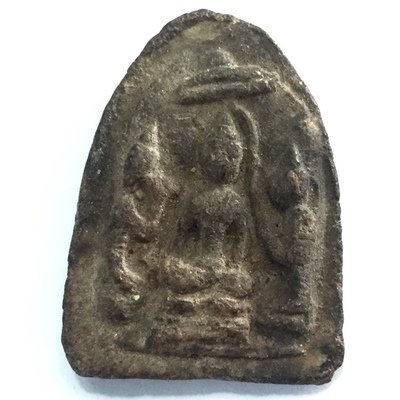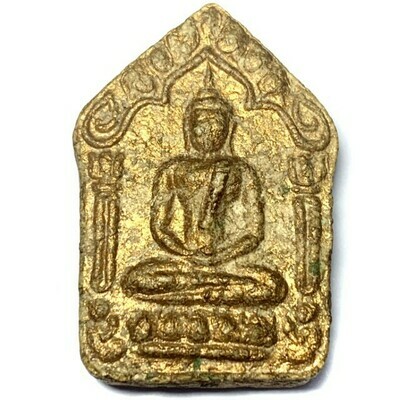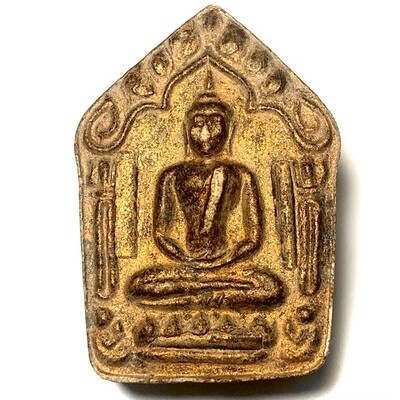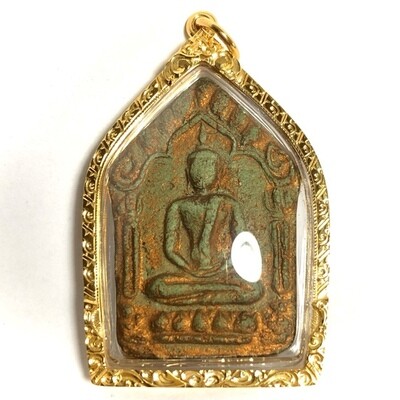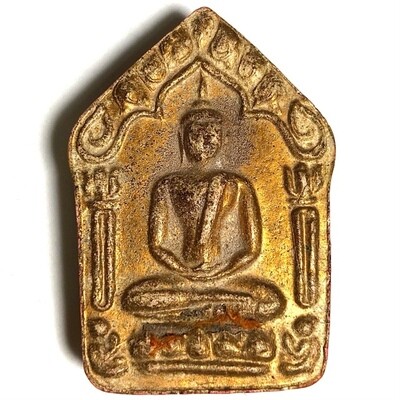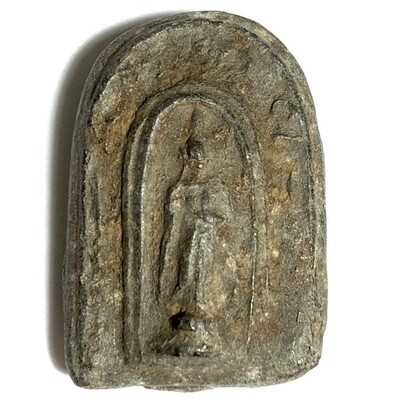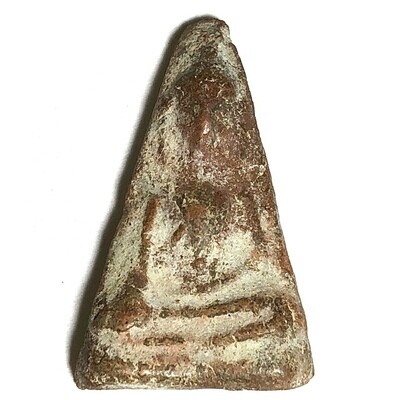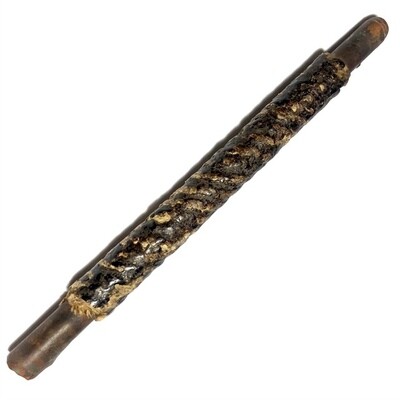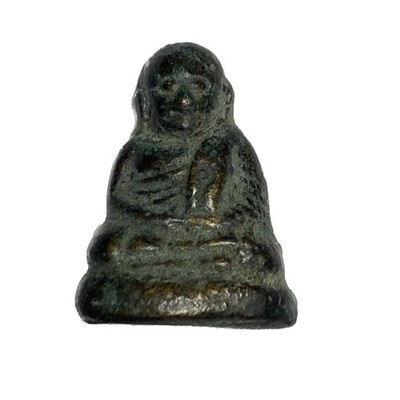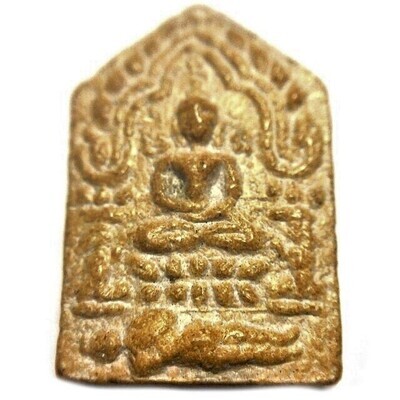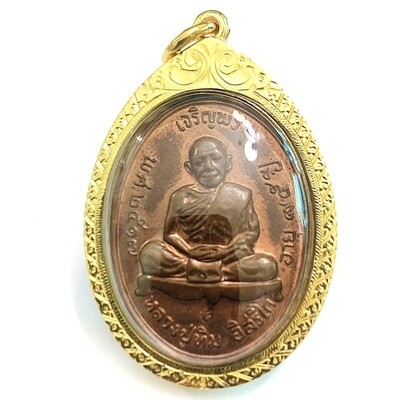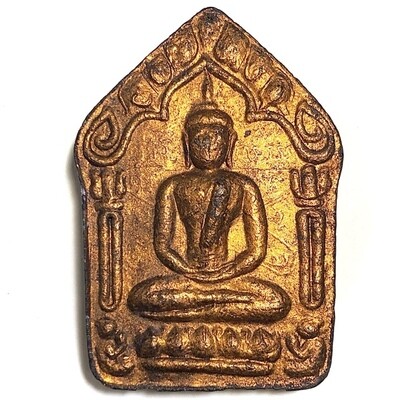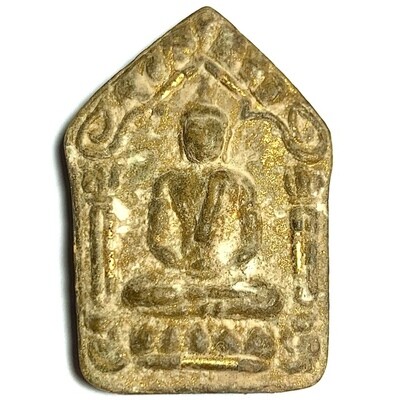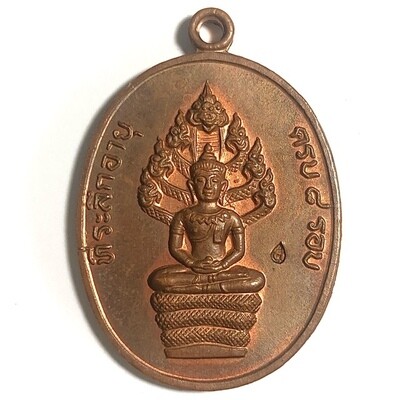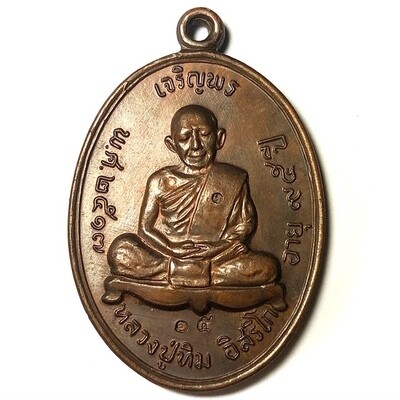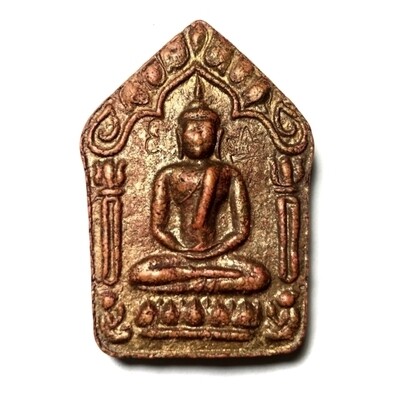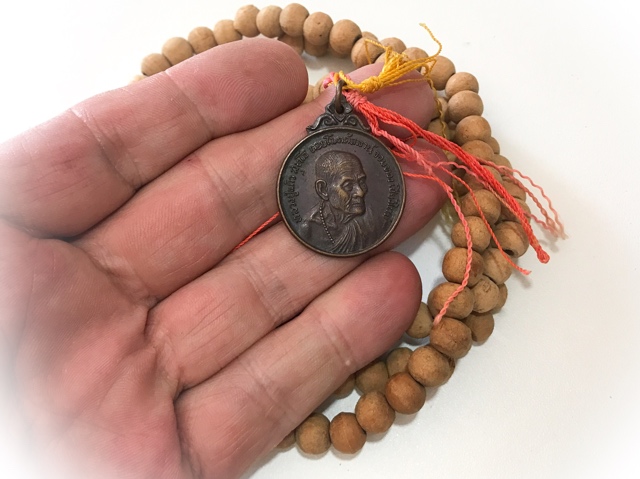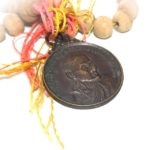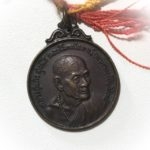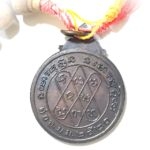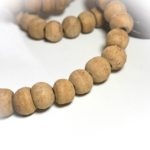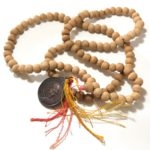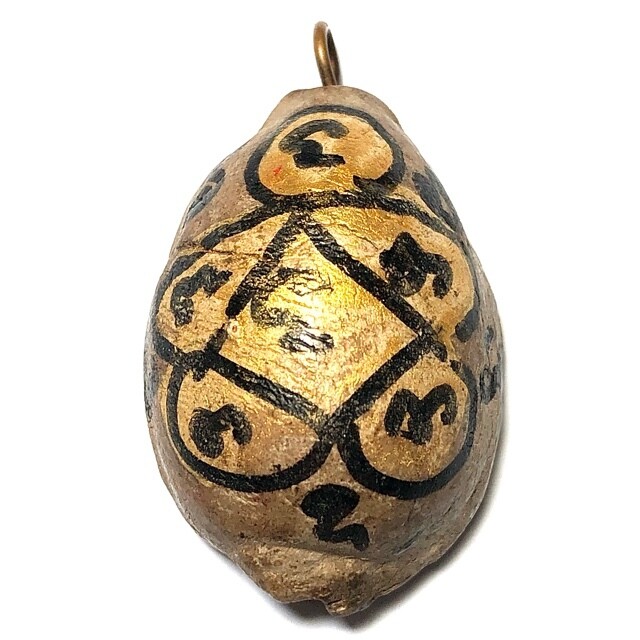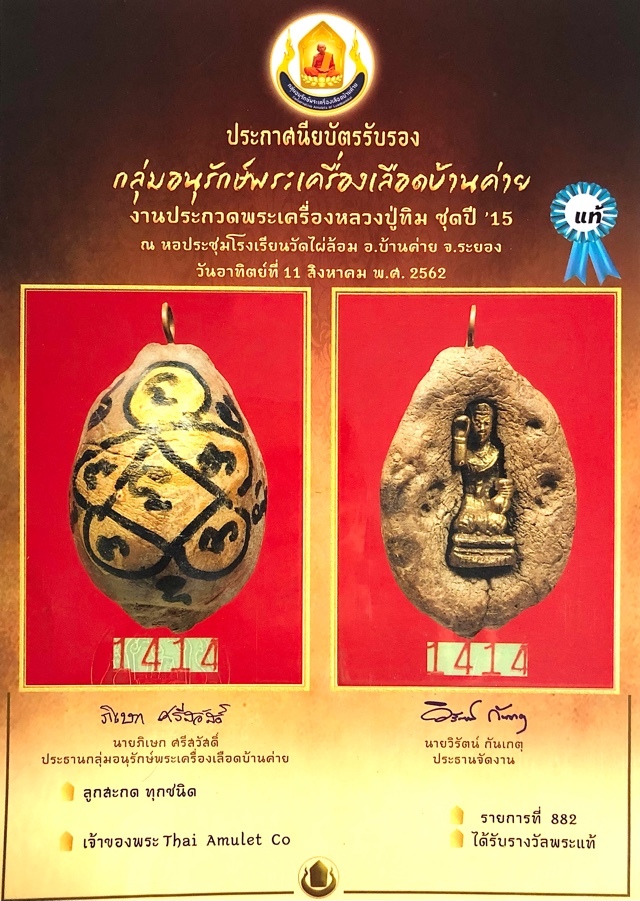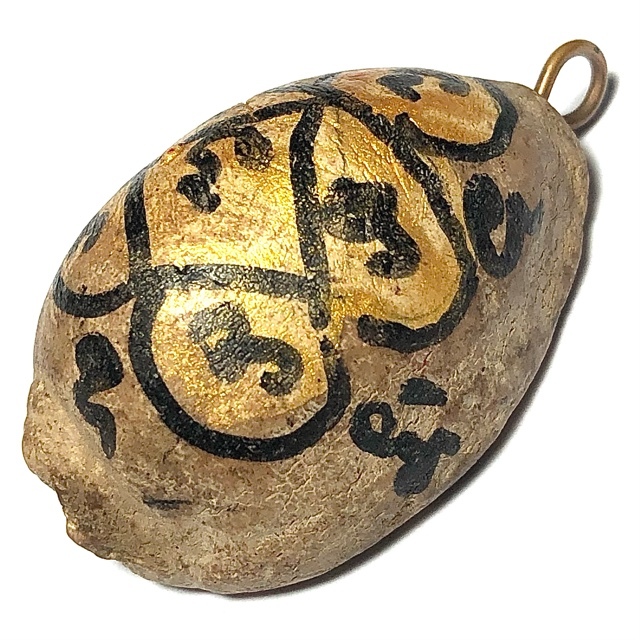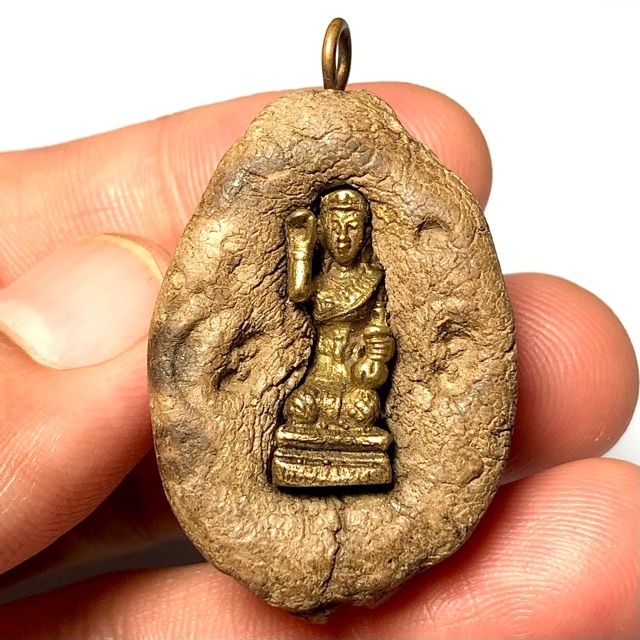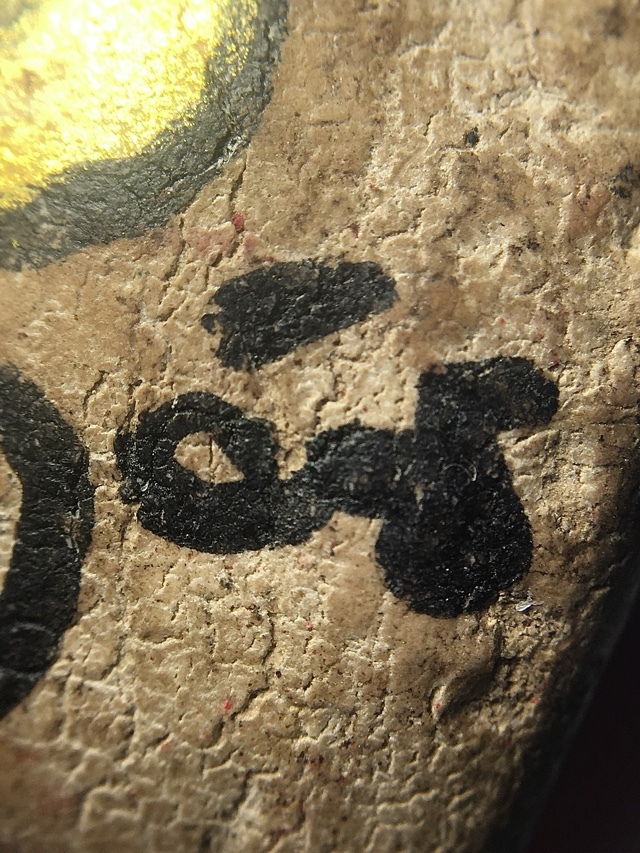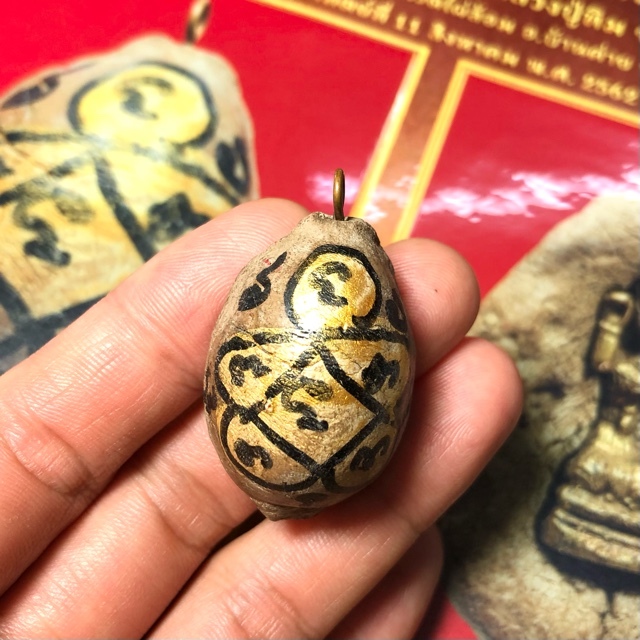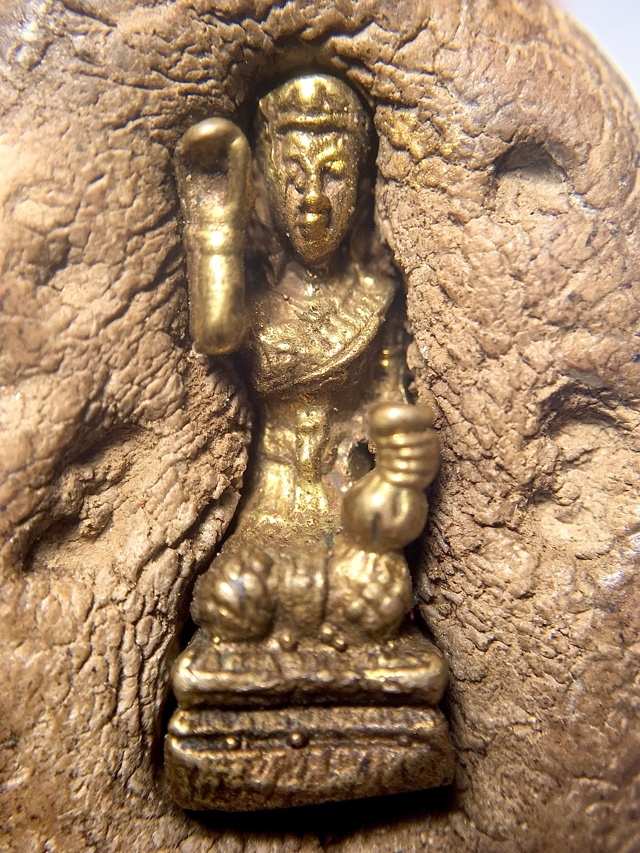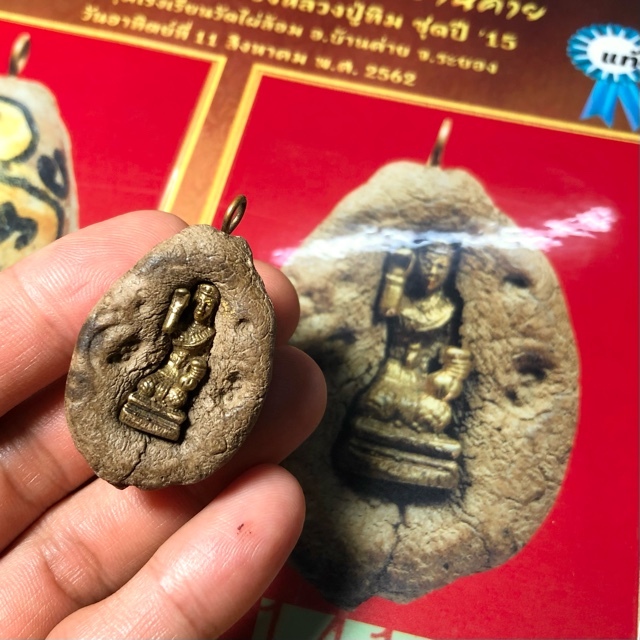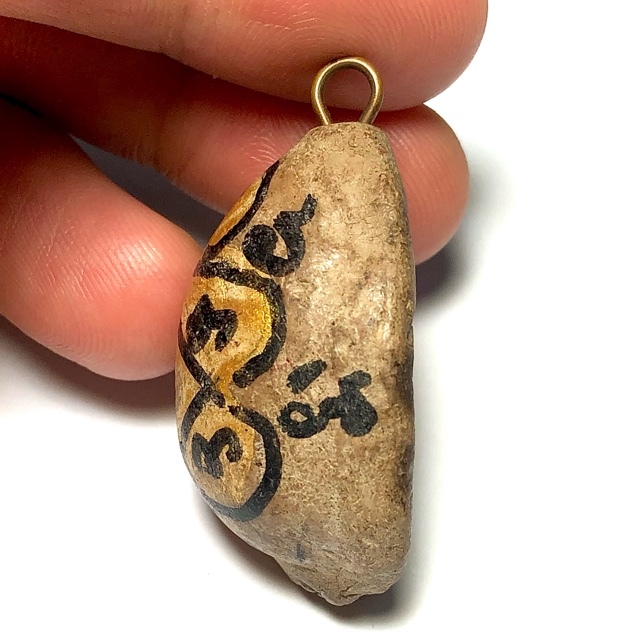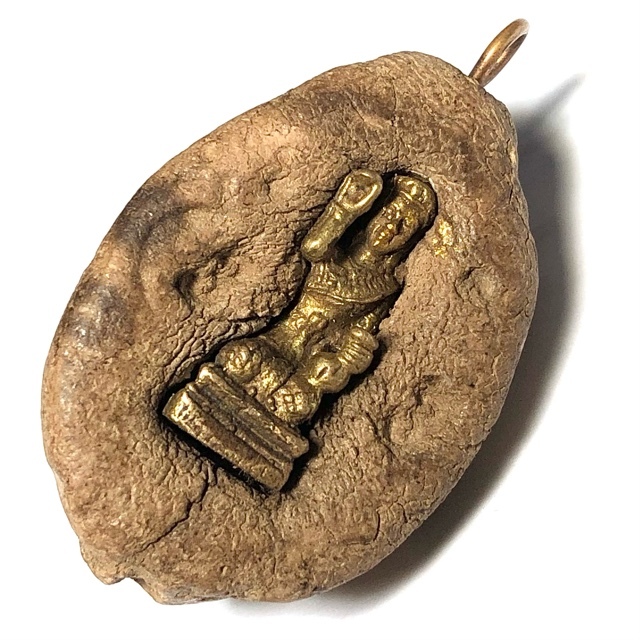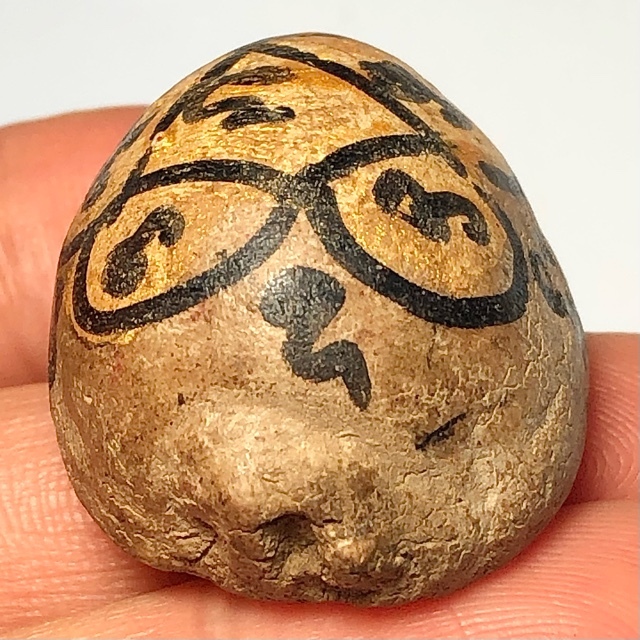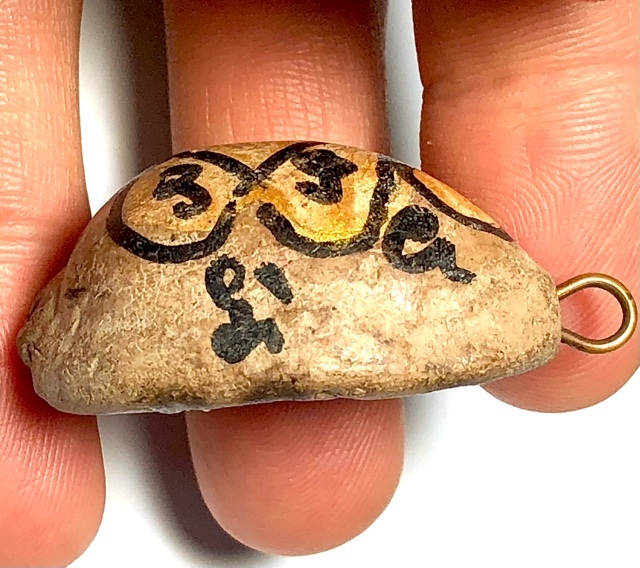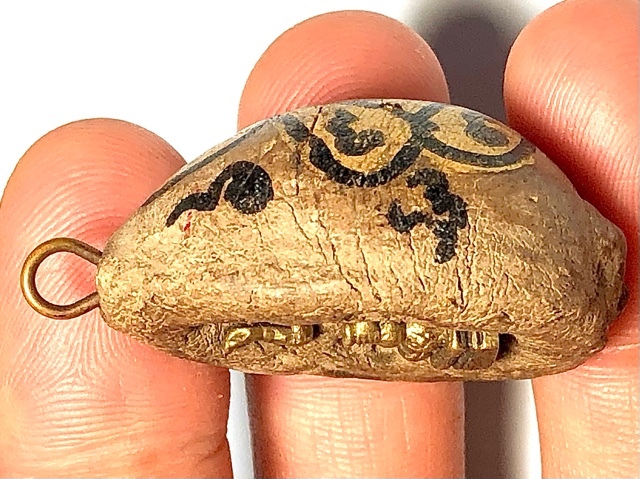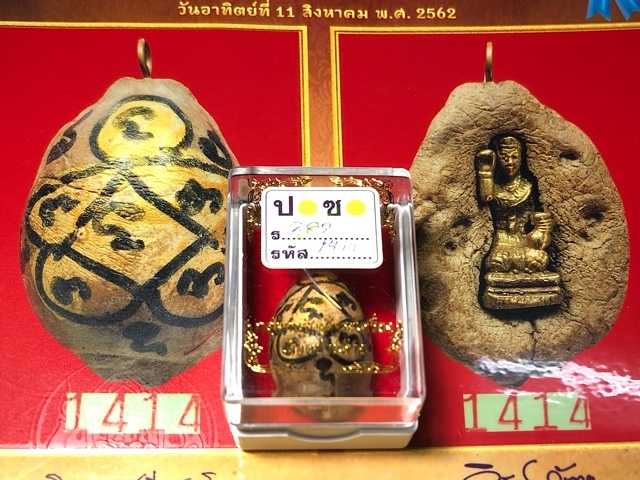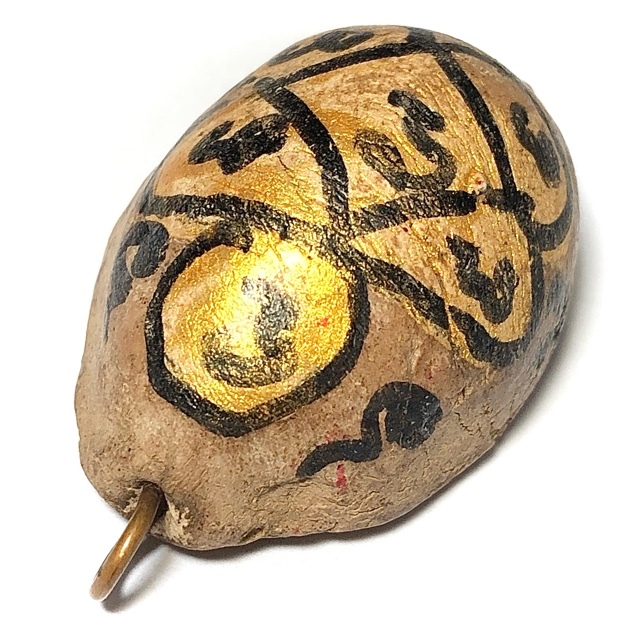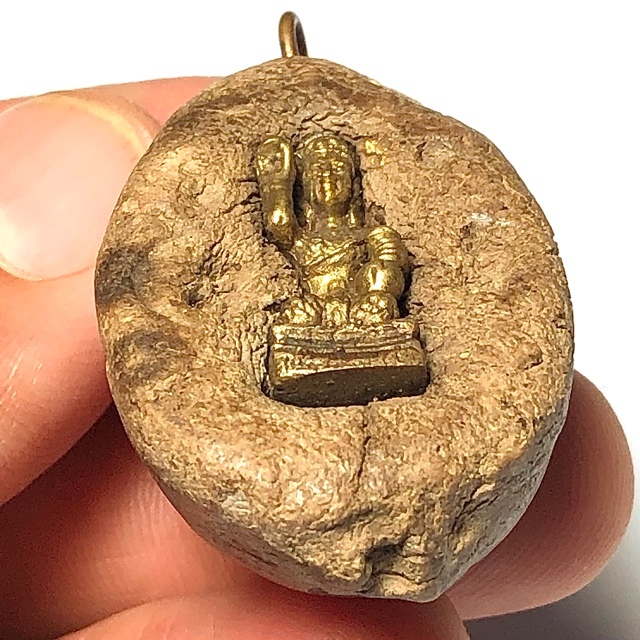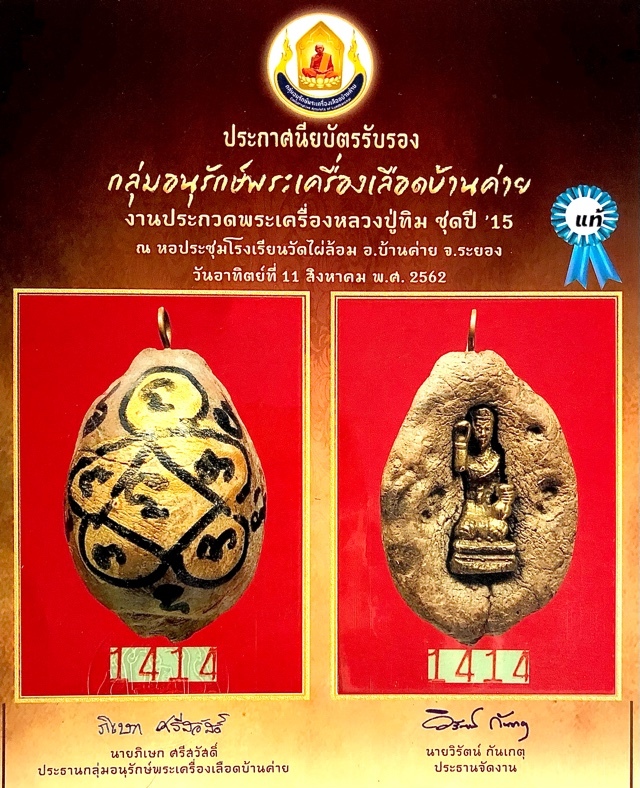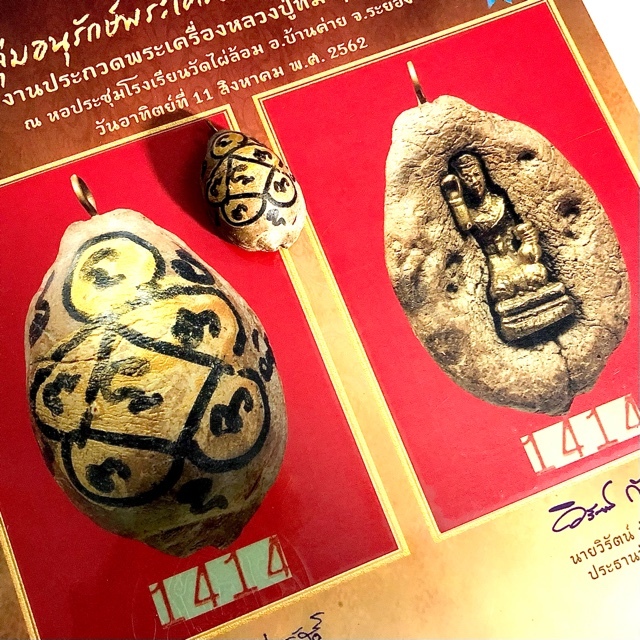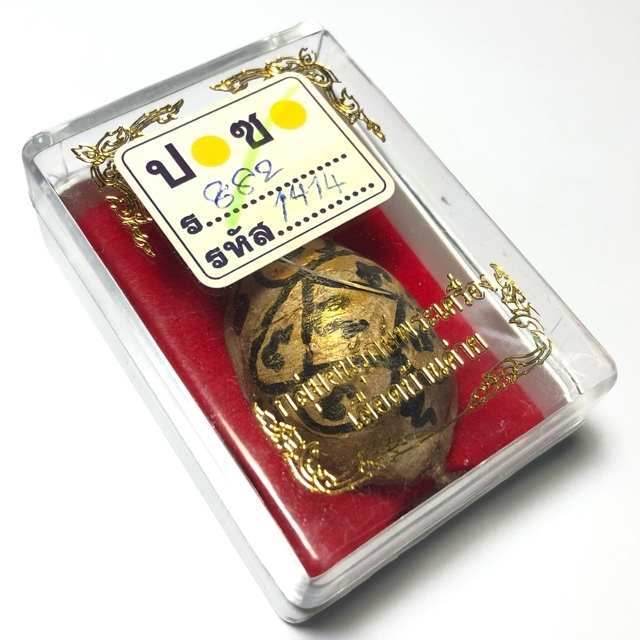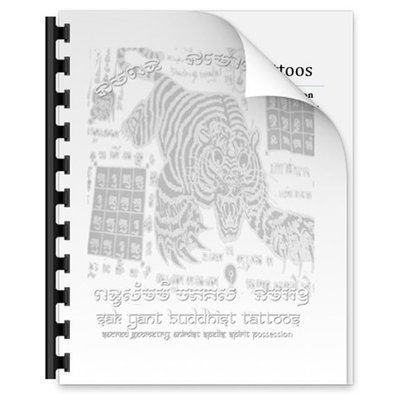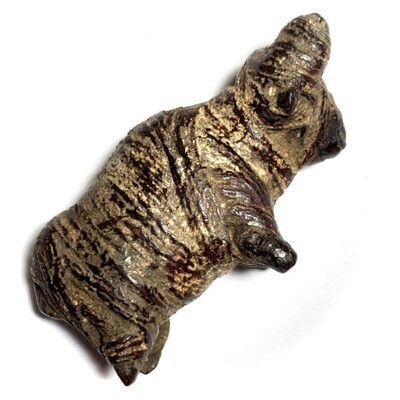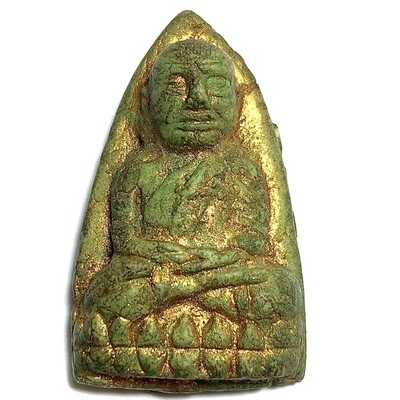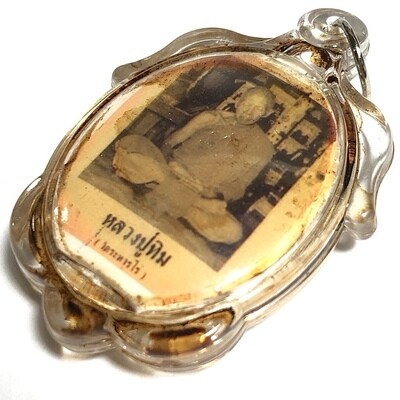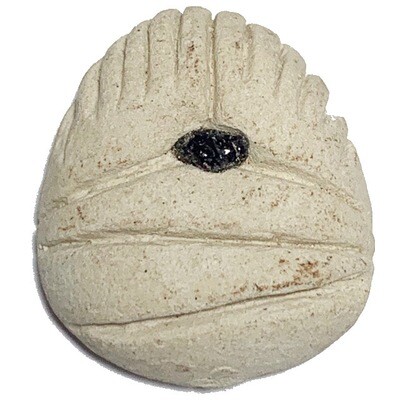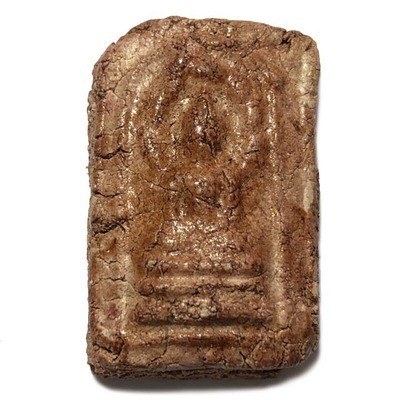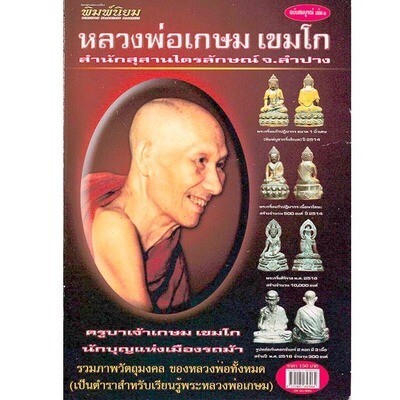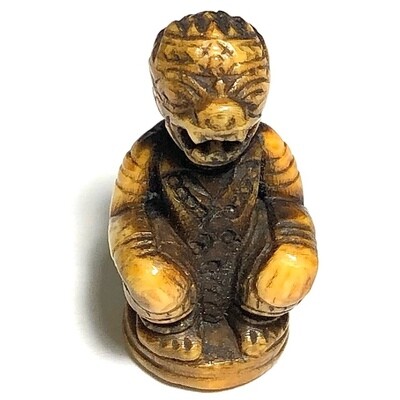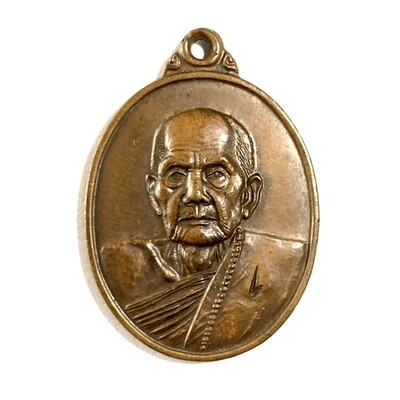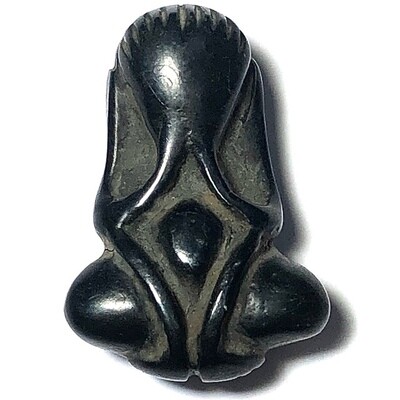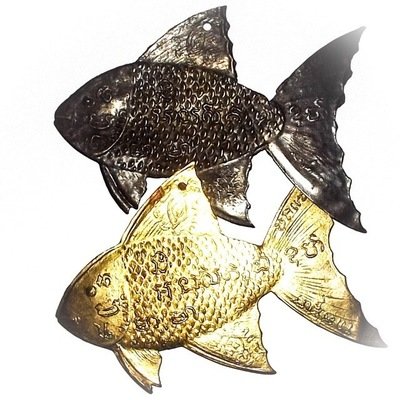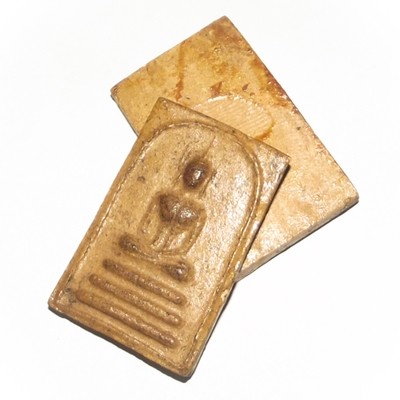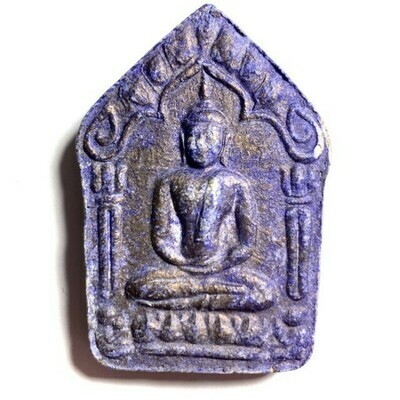Prakam 108 Met Nuea Mai Saksit Dtid Rian Kroo Ba Gaew 2520 BE – a Sacred wooden bead Blessėd Rosary with Guru Monk coin, from the great Lanna Monk, Kroo Ba Gaew Sutto, of Wat Doi Mokkhala, in Chiang Mai. Serm Duang (Good Karma) Maha Mongkol (Auspicious Blessings), Klaew Klaad (Evade Dangers), Maha Lap (Lucky Fortunes)
The rosary has a 2520 BE Rian Roop Muean Guru Monk Coin with the image of Kroo Ba Gaew gazing sideways on the front face, and a Sacred Nam Tao Yantra with Khom Agkhara on the rear face. A highly recommendable item for Buddhanussati and Gurunussati, Meditation, Prayer Counting, Protection and Mercy Charm. Wear as a necklace with amulet of the Guru. and use for counting your prayers and Kata Chants.
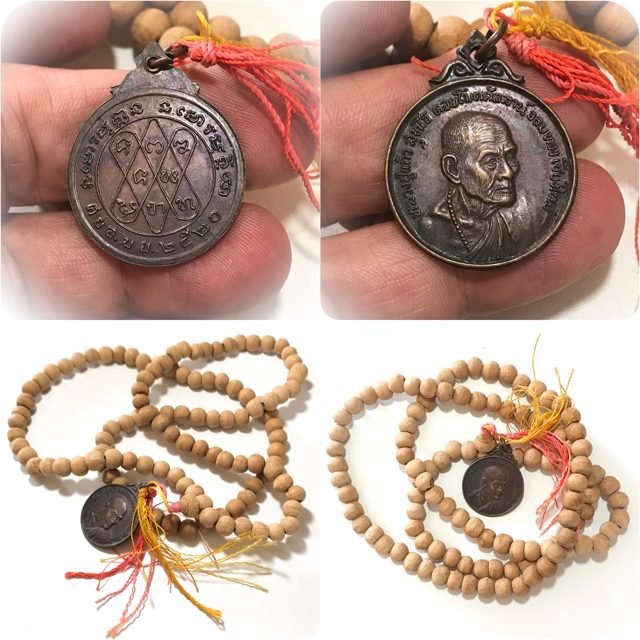
Luang Phu Kroo Ba Gaew was trained in his early ordination under the lineage of Luang Phu Mun Puritatto, and is one of the great Kroo Ba Ajarn of the Northern Lanna Region, who was a very close companion of the Great Luang Phu Hwaen Sujjino, of Wat Doi Mae Pang.
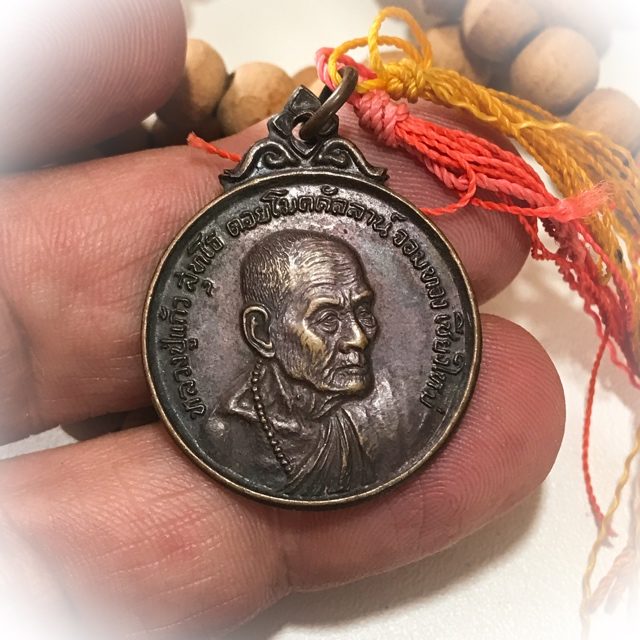
Luang Phu Kroo Ba Gaew has somewhat of a mysterious past, because his biography was never officially documented, and Kroo Ba Gaew himself was not prone to talk about himself very much. This of course common with High Arya Sangha who have practiced and attained inner peace, and is in itself a sign of great attainments. Sadly however, this results in little being known about his early life as a monk in the lineage of Luang Phu Mun, leaving us with only a partial knowledge of his Biography.
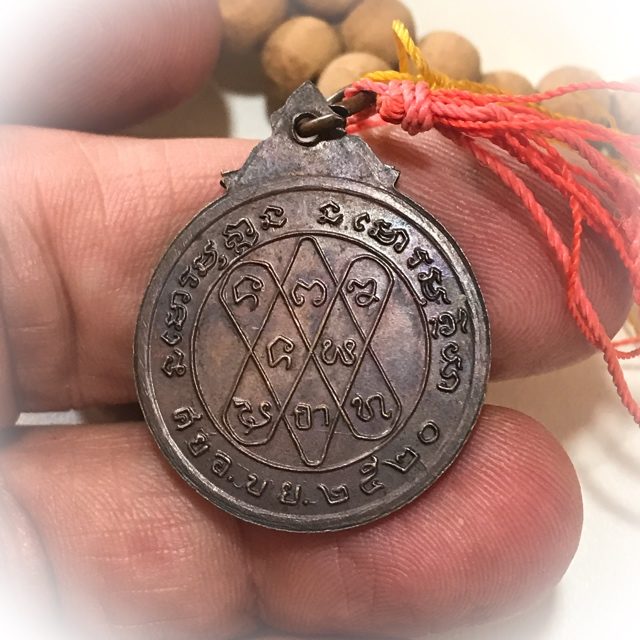
But the miracles of this Great Monk have been told and retold over many decades, and by word of mouth, Kroo Ba Gaew became a Great Kroo Ba Ajarn of the region, on the merits of Miracles made. It is said, that once during the time Kroo Ba Gaew was still living, a Naga Serpent came up from the underworld near the temple, and was run over by a truck as it slithered across the road, and was hurt. The Naga crawled up to the temple and called Luang Phu Kroo Ba Gaew to come out and heal him with holy water.
Another famous legend is the tale of the three Buddha images in the Mae Nam Ping river, which were embedded in the stream. Luang Phu Kroo Ba Gaew performed a ceremony to invite them to rise up from the waters to perform miracles for humanity, and come to reside at the temple.
The statues rose up from the depths and were able to be transported to the temple, where they reside to this day. It is said these Buddhas can make the rain fall in the proper season to make the crops grow, which is a matter of life and death from many farming communities in the region. The Buddhas are hence extremely sacred for the local devotees, and Kroo Ba Gaew’s miracle of calling them, is perhaps his most famous legend.
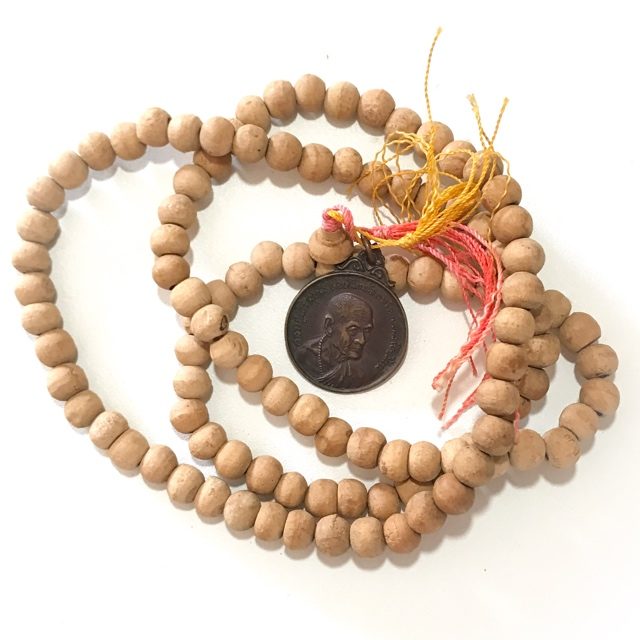
Luang Phu Kroo Ba Gaew’s amulets are extremely rare, because he never ever really focused on making amulets of many kinds. he would only release mainly Buddhist amulets such as his monk coins, and ‘Roop Tai’ blessėd monk photos, and items of reverence and practice such as the Prakam Saksit Blessėd Rosary. Devotees of Kroo Ba Gaew like to wear his rosaries with one of his coin amulets attached for prayer and protection of the Guru. HIs devotees are very reluctant to part with their amulets of Luang Phu Kroo Ba Gaew, for they believe them to possess very powerful protection, and bring auspicious blessings.
The Wongarn Pra Krueang Lanna Northern Amulet Appreciation Society have registered the pantheon of amulets of Kroo Ba Gaew as residing within the Dtamrap Pra Krueang Lanna Yord Niyom ‘Top List of Most Preferred Amulets of the Lanna Region’.
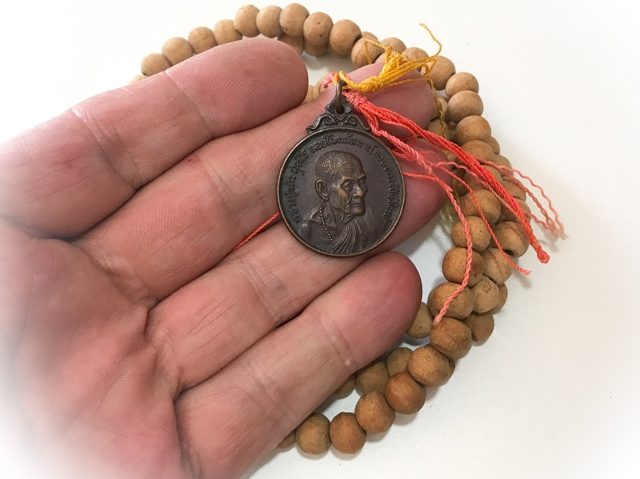
Use the Traditional Thai Buddhist Method for Bucha;
1. Chant Maha Namasakara (3 Times)
2. Chant the Trai Soranakom (3 Times)
3. Chant Kata Aaraatanaa Pra Krueang (3 Times)
Kata Maha Namasakara
Namo Dtat-Sa Pakawa-Dto Araha-Dto Sam-Maa Sam-Put-Dtat-Sa
Namo Dtat-Sa Pakawa-Dto Araha-Dto Sam-Maa Sam-Put-Dtat-Sa
Namo Dtat-Sa Pakawa-Dto Araha-Dto Sam-Maa Sam-Put-Dtat-Sa
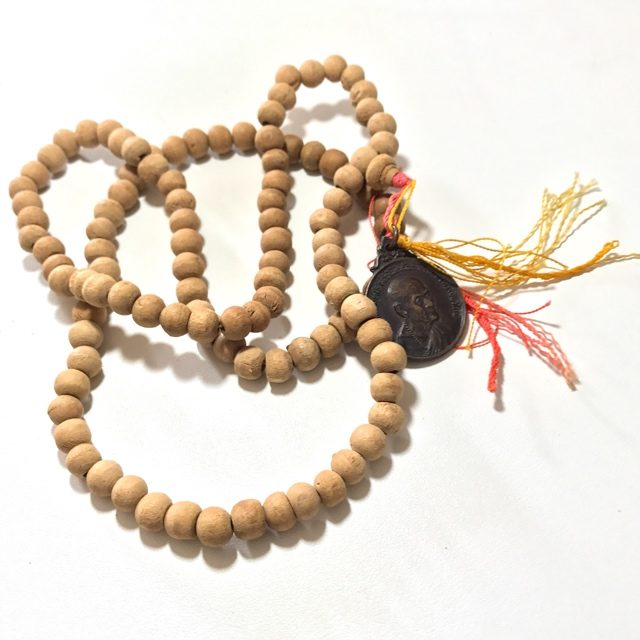
Trai Soranakom
Puttang Cheewidtang Yaawa Nipaanang Saranang Kajchaami
Tammang Cheewidtang Yaawa Nipaanang Saranang Kajchaami
Sangkang Cheewidtang Yaawa Nipaanang Saranang Kajchaami
Tudtiyambpi Puttang Cheewidtang Yaawa Nipaanang Saranang Kajchaami
Tudtiyambpi Tammang Cheewidtang Yaawa Nipaanang Saranang Kajchaami
Tudtiyambpi Sangkang Cheewidtang Yaawa Nipaanang Saranang Kajchaami
Dtadtiyambpi Puttang Cheewidtang Yaawa Nipaanang Saranang Kajchaami
Dtadtiyambpi Tammang Cheewidtang Yaawa Nipaanang Saranang Kajchaami
Dtadtiyambpi Sangkang Cheewidtang Yaawa Nipaanang Saranang Kajchaami
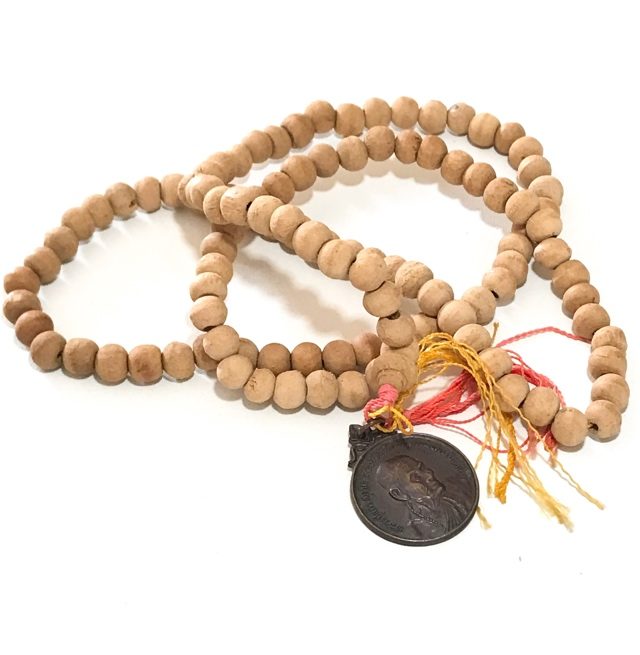
Kata Aaraatana Pra Krueang
Puttang Aaraatanaanang
Tammang Aaraatanaanang
Sangkang Aaraatanaanang
Puttang Prasittimae
Tammang Prasittimae
Sangkang Prasittimae
Look Sakot Pong Prai Kumarn Fang Nang Kwak Yuk Dton Early Era Amulet & Authenticity Certificate Luang Phu Tim Wat Laharn Rai
An extremely rare, and by many yet unseen Early-Era Look Sakot Prai Kumarn talismanic charm of the Great Luang Phu Tim, with hand inscribed Yant Grabong Khwai, and Nang Kwak Loi Ongk Statuette inserted into the Muan Sarn Sacred Powders of the look sakot. This exhibit is an especially rare and individualistic talismanic charm to encounter form Luang Phu. The Muan Sarn Sacred Powders are visibly rippled with the shrinkage of surface tension that occurs over many decades, and has the Laekh Sam (code 3) stamp of the artisan Chang Pattana Anugul, designer of Luang Phu's famous Palad Khik Lingam amulets.
The Muan Sarn Sacred Powders of the Look Sakot Prai Kumarn Luang Phu Tim have a very rich texture, appear highly concentrated, and contain the same famous Prai Kumarn bone powders found in the extremely expensive Pra Khun Phaen Pong Prai Kumarn amulets of this Master. For this reason, Look Om and, in this case, a rare Look Sakot, are considered a perfect alternative (and much more affordable,) to the Pra Khun Phaen Pong Prai Kumarn Luang Phu Tim.
This exhibit is visibly made with the addition of sacred earths to the Pong Prai Kumarn Muan Sarn Sacred Powders. The Classic Look Om, and a very few discovered examples of Look Sakot amulets came into existence because, after the pressing of Luang Phu Tim's Pra Khun Phaen Pong Prai Kumarn, Pim Yai, and Pim Lek amulets, there was much of the Muan Sarn Paste which had become too dry for it to be pressed into the finely detailed block press molds of the Pra Khun Phaen amulets.
And so this remainder of Pong Prai Kumarn Powder Muan Sarn, was then rolled into wishing ball amulets, and, in a few cases as seen here, Look Sakot, as the powders were just too powerful and Sacred to dispense with without making them into amulets. And so it was, that the famous Look Om Pong Prai Kumarn came into existence. The Look Sakot however, is so rare, that the legend remains affixed to the Look Om, because only the most avid students of the pantheon know the Look Sakot, and its rarity prevents it from being mentioned often.
The Pra Pong Prai Kumarn sacred powder amulets of Luang Phu Tim are considered by most people to be among the mopst powerful amulets, for their immense mercy charm. The Original Look Om of Luang Phu Tim Wat Laharn Rai are known to differentiate themselves from other editions released by Luang Phu Tim at other temples. This is for his use of Bronze Wanich golden paint, to cover the Look Om With only in the editions he released through his own temple.
Other temple releases of his Look Om are of course equally authentic and Sacred, but less preferred than the ones which came through direct release at the temple of Wat Laharn Rai. Half the reason being that Luang Phu would use a much more highly concentrated mixture of Pong Prai Kumarn in his own direct releases.There are however no records of him ever releasing Look Sakot at other temples other than his own. This makes the wlr releases slightly more preferred, for the related temples where he allowed the release of his amulets, and assisted in the blessings, would also mix other Muan Sarn Sacred Powders into the mixture, which despite also being extremely sacred and powerful, would then allow for less quantity of Luang Phu's highly prized and revered powerful Pong Prai Kumarn powders to be added.
It is hence considered that the Wat Laharn Rai release versions are believed to be much more powerful Maha Lap and Maha Sanaeh type Magic, which are two of the preferred powers with those who like to use SAeduction for Love and Business, and Gambling, Lottery and Wealth Attraction. The second reason for the Wat Laharn Rai Prai Kumarn amulets being the most highly revered and preferred is more of a speculative one, which means they tend to win over other editions in competition, and are considered to have more aesthetic beauty to them for their high presence of Pong Prai Kumarn and the special high quality 'Bronze Wanich' golden coating.
It is a part of the amulet appreciation society expert's method of authentication to examine and study the appearance of how bronze Wanich golden paint develops in surface texture, tonality and porosity of the surface, as well as the appearance of Luang Phu Tim's famous Pong Prai Kumarn which rises up and through the surface of the fine golden painted surface.
We ourselves feel that all of Luang Phu Tim's amulets are equally Sacred and Powerful in their own way, regardless of which edition or which temple he blessed them at, but we do, as do all Amulet Appreciation Fanatics, recognise the categories of preference within the heirarchies of different editions, which is for us one of the more subtle and fascinating parts of the study of high end amulets within the collector scene, and part of the fine art of learning how to recognise and value Sacred Amulets of High Preference and Rarity.
The Look Om Pong Prai Kumarn Luang Phu Tim amulet, has has been one of the most popular amulets in the whole Pantheon of Thai Buddhist Amulets of the last century, and of all time, and is now almost impossible to encounter commonly anywhere in any amulet emporium, except for the most elite showrooms, and at elevated prices. The Look Sakot is however an essential rarity that can only be described perhaps, as even rarer, therefore less known, and is a once in a lifetime chance at encountering such a rare variation with Nang Kwak and hand inscribed Yant.
This Look Sakot can be considered a true collector's item for the avid devotee who seeks a Talismanic Charm of Great Power and Immense Rairty of Luang Phu Tim. Much rarer even than his internationally renowned Look Om. The Look Om sacred powder balls were perhaps the most affordable of the Old Classics of Luang Phu Tim when we consider the prices at which his Pra Khun Phaen Pong Prai Kumarn and other master Class Buddha Amulets demand, for which reason, the Look Om Luang Phu Tim is the most highly popular amulet with devotees who do not possess the finances to afford a Pra Khun Phaen Luang Phu Tim, which can cost many thousands of dollars, and even tens of thousands of dollars.
Nang Kwak is deemed to bring luck in business, especially in the form of money and possessions coming in to the household. She is the patron Deity of all Merchants and Salesmen and can be seen in almost every business establishment in Thailand. The legend of Nang Kwak, is something that occurred a long time ago, before or during the time when Buddhism was beginning to spread, about 2500 years ago. The legen tells that, in the Indian province of Sawadtii in the small town of Michigaasandhanakara (มิจฉิกาสันฑนคร)There was a married couple whose names were Mr. Sujidtaprahma (สุจิตตพราหมณ์ ) and Mrs. Sumanta (สุมณฑา), who had a daughter named Supawadii (สุภาวดี).They were merchants who sold small amounts of wares on the markets, only earning just enough to maintain their small family from day to day.
KATA NANG KWAK
One day, they were discussing their hopes and dreams for the future, and decided that they should try to expand their business to make more profit and begin to think of being able to save something for their old age; as a result of this conversation, they decided to try to afford to buy a "gwian" (cart) in order to use to travel with and sell their wares to other towns and villages, also then bringing wares from the other towns to sell in Sawadtii and Michigaasandhanakara when they returned. Sometimes, Supawadii their daughter, would aske to tag along for the ride, and help them. One day, as Supawadii was helping her parents to sell wares in a distant town, she was lucky to be able to hear a sermon by Phra Gumarn Gasabatera (พระกุมารกัสสปเถร); she was so convinced and moved by his sermon, that she took refuge in the Triple Gem. When Gasabatera saw her faith and devotion, he collected all his powers of thought and concentration of an Arahant* (for indeed Phra Gasabatera was an Arahant), and bestowed blessings of good fortune and luck in salesmanship on Nang Supawadii and her Family. In addition, Phra Gasabatera increased the power fo the blessing to make the magic stronger every time that Nang Supawadii would attend and listen to Dharma teachings with such devotion as she had this time.
In the next town they went to to sell wares, nang Supawadii recieved the opportunity to listen to the preachings of Phra Siwaliitera (พระศิวลีเถร), who was also in the business of wandering around preaching the Dharma as taught by Lord Buddha Sakyamuni. Nang Supawadii received teachings from this master, and thus became extremely well versed and knowledgeable in Dhamma. Phra Siwalii bestowed blessings of Metta upon her for her diligent efforts to follow and understand the practise of Dharma.Phra Siwalii tera was different from normal beings and had a strange event marking his birth; namely that, he remained in his mother's womb for a period of 7 years 7 months and 7 days before being born in the world.This cause Phra Siwalii to be endowed with extremely strong mind powers, which, when he concentrated all his mental power and effort to bestow the Metta blessing upon the young Supawadii, the result was an especially strong effect to the blessing he gave.
Due to these blessings gained from the two saints, it came to notice that every time Nang Supawadii came along for the ride on her parents' cart, sales were fantastic and all the goods were always sold in no time at all! As the when Nang Supawadii did not accompany them on their market sounds; sales were pretty meager in comparison.Her parents decided that their fortune would be best if they had their daughter Supawadii accompany them always on their sales rounds because they believed that the good fortune was to do with the blessings and meritshe had with her.Thsi broght such great fortune upon the family, that in a short time they became extremely wealthy merchants.
Once they had already become pretty wealthy, Mr. Sujidtaprahma received the opportunity to hear some Dharma teachings from the Lord Buddha himself; he was filled with faith and reverence, and as a result of this, began to practise Dharma practise and reached the attainment of Sotapanna ( โสดาบัณ- Soedaaban, in Thai) which is otherwise known as "Stream Enterer".Supawadii's father then donated a park called "Ampatagawan" (อัมพาฎกวัน), for the Bhikkhus to rest and take shelter in, as well as building a Vihara (shrine and salon) for the Monastics, as a temple withing the grounds.The temple was named "Wat Machigaasandharaam" ( วัดมัจฉิกาสัณฑาราม), Phra Sutamma Tera was invited to be Abbot of the temple. Mr.Sujidtaprahma, who was very well known for being a person who would g out of his way to help others, and a good hearted generous fellow, would ask people on his selling rounds if anyone was going the same way and wished to hitch a ride with him. Sometimes there would be as many as a thousand people wishing to accompany him, which he never refused, always fulfilling their wishes, regardless of if they were followers of the Buddha like himself or not.The many people who got to ride with him noticed the amazing power of Metta Mahaniyom of his daughter Nang Supawadii, whose blessings had caused her parents to become wealthy merchant moguls, and thus began to worship her as a cause of good fortune in selling and business matters. After many years, Sujidtaprahma and his wife Mrs Sumanta became old and passed away - their blessed daughter Supawadii also became old and eventually had to pass on to the next life, and left her body behind.
But her legend lived on in the hearts for all the people who had adopted her as the patron saint and magical deva of all merchants, praying to her and making offerings to increase merit and receive great fortune in business dealings.Anyone wishing to have good luck in their sales would seek out an image or statue of Nang Supawadii and make Poojah offerings to her, inviting her spirit to come and reside in the statue or image, and bring them luck, as Supawadii had always done whilst riding on her father's cart.All of 4 different castes of the Indian Hindu caste system adopted the Practice; Brahmins, Royalty, Medics, and even Sutras were seen to worship and respect Nang Kwak. The practice of making Poojah to Nang Kwak became ever more widespread du to tales of many merchants practicing Poojah Nang Kwak, and becoming extremely wealthy; this caused people in all four directions of the compass to adopt the practice. The practice of praying to Nang Kwak was adopted by the Thais as Buddhism and the Brahmin faith came to Thailand, and is as prolific today as it ever was in ancient times. The Brahmins, who are practioners of kata in a very big way, brought the statues of Nang Kwak here with them, changing the posture of the statue from that of a lady sitting on a cart, to that of a lady sitting in a shop waving to beckon customers.First of all the Brahmins used it for their own business, but when they saw that people in Thailand believed in the powers of Nang Kwak, they began to make the statues to, chanting and invoking the kata and blessing the statues to sell to other Thai Merchants for making Poojah to.Nang Supawadii then received her new and more commonly know name, due to her sitting and waving position in the new statue form "Nang Kwak" (waving lady - Kwak means to wave and beckon with the hand). You can see Nang Kwak waving and beckoning to you to come and buy wares in almost every business establishment in Thailand, so now when you see her as a statue or a Yant Cloth (Pha Yant), you will know what it represent

The Look Sakot is both a highly attractive and an extremely rare to find Sacred Amulet, that is truly Powerful and stands as the Master Class Amulet of its Category, and is considered a Most Highly Prized addition to any Master Class Collector's Showcase, and more importantly, is a most powerful amulet to possess for Bucha, and receive the Blessings and protection of of Luang Phu Tim's powers.
The making of the Muan Sarn Sacred Powders Look Om Pong Prai Kumarn Luang Phu Tim, came from the Wicha which Luang Phu had inherited through apprenticeship form one of his high Kroo Ba Ajarn, Kroo Ba Sangkh Tao, who was also his true Uncle. Part of the formula included Pong Prai Maha Phuudt, which was made from the Skull of a male Kumarn who died in the Womb, and who died on a Saturday and was cremated on a Tuesday. This is part of the ancient Khmer Necromantic Formula for Authentic Powerful Prai Occult Magic, as practiced in Ancient Times.
Due to the fact that Monks are not allowed to seek and find this Sacred and Extremely Powerful Necromantic Substance, Luang Phu would perform Korb Kroo Initiation for protection against Black Magic and the Phuudtaa Spirit Phantoms, so they could go forth to seek and find the substances to donate to him for the making of the Pong Prai Kumarn. The Initiated Lay Devotees and Apprentices to his sorcery, would then wait for the news of the right circumstances of death of Kumarn Ghosts, and go out to collect the substances and prepare them as instructed with the Wicha. They would seek the permission of the relatives of the dead, to obtain the substances to enable the ghosts of the deceased to receive merits to free them from their Karmic residues by donation of their mortal remains to be made into amulets.
They would receive the ceremonial ritual liberation of their souls from Luang Phu Tim, who would speak with the spirits of the dead to receive their acknowledgement for the process of transformation through the Nibbana Sutra, and the Muan Sarn would then be prepared according to the Dtamra Saiyasart of Necromancy, to make the Pong Prai Kumarn. Luang Phu instructed his apprentices and the relatives of the Funerals to take care not to incinerate the whole skeleton, but to keep the skulls to bring to Luang Phu to use them for the making of the Pong Prai Kumarn. This is one of the reasons why his Pong Prai Kumarn is so powerful, because it does not contain the skeleton bone powders, rather, only those of the skulls.
As a result, Luang Phu Tim's Pong Prai Kumarn has been recorded by experience of devotees to posses the highest Maha Pokasap Power of all Pong Prai Kumarn ever made, with Immense Metta Maha Niyom and Klaew Klaad Power, to induce Mercy Charm, Attract Lucky Fortunes (e.g. Lottery Winnings), and to Protect from Deadly Accidents and Disasters.
Despite the fact that the Look Sakot, and Look Om Pong Prai Kumarn Luang Phu Tim Wat Laharn Rai carry a lower price than his famous Pra Khun Phaen Pong Prai Kumarn, the power of the amulets is just the same as the Pra Khun Phaen, with the only difference being the lower price. The look Om and Look Sakot, were always made using the remaining Muan Sarn Sacred Powders after the limited edition Pra Khun Phaen were all pressed. Any extra Muan Sarn would always be rolled into Look Om, and empowered by Luang Phu Tim in this form. Only few Lok Sakot have been seen in comparison to Look Om, making this exhibit an immense rarity.
The Look Sakot is hence the preferred choice of both the wise investor and devotee, as well as the perfect choice for those Devotees who seek the immense power of Luang Phu Tim's amulets, but cannot afford the price of the Pra Khun Phaen Pong Prai Kumarn Luang Phu Tim.

Luang Phu Tim Issarigo, is of course not only one of the most highly acclaimed and sought after Guru Monks for his amulets, he is the holder of the highest esteem in Thai Buddhist amulet history for Pong Prai Kumarn powders. Luang Phu Tim, is Internationally Acclaimed, for his famous Pra Khun Phaen Pong Prai Kumarn, and Look Om powder balls. As to the classic 'Rian mage amulets which have become all time favourites, and eternally, world famous classic amulets of the high end variety.

 Since his passing, his devotees and apprenticed monks, have now become the world's top living masters for the making of Pra Khun Phaen Pong Pra Kumarn, and literally dozens of encyclopaedic books, have been printed, documenting both this great master monk, and his classic amulets of high esteem.
Since his passing, his devotees and apprenticed monks, have now become the world's top living masters for the making of Pra Khun Phaen Pong Pra Kumarn, and literally dozens of encyclopaedic books, have been printed, documenting both this great master monk, and his classic amulets of high esteem.
Buddhist monk coins with his image and others with Buddha images and other deities and imagery are amongst the most highly collected amulets and most expensive of all of the great Luang Phu Tim. He has various direct lineage apprentices, Who are continuing to progress and spread his most powerful and world-famous Wicha.
Of all of these masters, perhaps the most famous, preferred, was Luang Por Sakorn, of Wat Nong Grub, who is also now deceased, and whose amulets are fast becoming just as highly sought after. In second place one could possibly estimate the great Luang Phu Sin, of Wat Laharn Yai, and in third place, possibly, Pra Ajarn Somkid, of Wat Beung Tata (Rayong).
